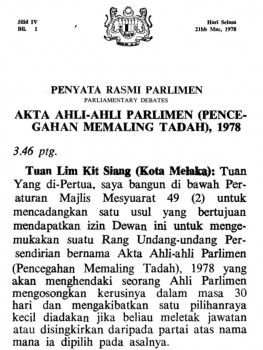By T.K. Tan
 October is the month for budgetary number crunching again. It is time to reflect on what those numbers mean for us. It looks rosy on paper; the economy is still humming, with GDP growth expected to be more than six percent this year and with unemployment at a healthy 3.4 percent for the second quarter of 2010. But is our economy resting on firm foundations?
October is the month for budgetary number crunching again. It is time to reflect on what those numbers mean for us. It looks rosy on paper; the economy is still humming, with GDP growth expected to be more than six percent this year and with unemployment at a healthy 3.4 percent for the second quarter of 2010. But is our economy resting on firm foundations?
In light of the Tenth Malaysia Plan (10MP) and New Economic Model (NEM) launched this year, where will Budget 2011 fit in with these master plans? In the NEM, the National Economic Advisory Council (NEAC) has set the target for Malaysia’s economy to grow at 6.5% per annum in order to achieve per capita GNP of RM54,800 (USD17,700) by 2020, which would propel us to the high income economy status. As for the 10MP, as an intermediate blueprint, it calls for Malaysia to achieve RM38,845 (USD12,139) by 2015.
For the economy to achieve high income status, it needs skilled workers. As stated in the NEM report, 75 percent of the country’s workforce are unskilled workers, with 80 percent of the workers having an education of SPM or less. When compared with South Korea (35 percent skilled labour and more than 25 percent with some form of post secondary education) and Taiwan (33 percent skilled labour), it clearly shows we have a long way to go.
A peek at the issues
In the 10MP, the government has proposed that RM150 million be used to train 20,000 school dropouts and RM7.5 million to train their coaches. Is this enough? A quick tabulation shows:
1) At an average of RM7,500 per person and assuming RM500 per month for the course fees and 15 months of training, is it adequate to train a person to have skills that will churn out products worth millions?
2) At RM7.5 million, assuming 500 instructors (for one instructor per 40 students), which means RM15,000 per instructor, is it adequate to train them in sufficient time (assuming 30 months) so that they are qualified to teach the trainees?
In addition, there would surely be more than 20,000 dropouts in a year. Does the government intend to provide training for them?
Polytechnics and community colleges play an important role in training skilled workers. In the previous budget, RM612 million were allocated for polytechnics and community colleges compared with RM6.88 billion for public universities. With the workforce being overwhelmingly low-skilled and unequipped, there seems to be a mismatch of priorities in attention and resources given for educating workers. And yet there is only a brief mention in the 10MP of recognising Technical Education and Vocational Training (TEVT) for strengthening technical post secondary education.
Tertiary education
Malaysia is expected to have 1.5 million university students in 2010, which is close to nine percent of the total 16 million workers in the country. However, the local universities seem to be churning out quantity, not quality graduates. The take-up rate for graduates has been hovering around 50 percent from 2006 to 2009, compared with 82 percent in Singapore. There needs to be a rethinking of the education approaches and priorities in our local universities.
The government is spending generously on scholarships; from 2000 to 2009, first degree scholarships spent increased from RM221 million to RM865 million. However, these talents have yet to be fully utilised by government; statistics shows that from 2003 to 2007, only 16 percent of the Public Service Department (JPA) scholars have served their bonds and worked in the civil service. The current incentive scheme is not working in retaining them.
For those with Higher Education Loan Funds Public (PTPTN), there is motivation on the part of the borrowers to follow through their studies and work in their related fields so as to maximise their income potential. The government’s reinstatement of the waiver of PTPTN for top students in 2010 (it was ceased in 2005) is commendable; however, what of those who graduated in the years 2006-2009? Many of them felt demoralised by the government’s flip-flopping policy. Would they and future graduates have trust in the government and the country?
Foreign talent
One of the areas identified by the NEAC to speed up the country’s alleviation of knowledge and skilled worker shortage is attracting foreign talent. The government has commendably begun to restructure the country’s expatriate policies. Some of theses incentives, however, seem piecemeal. For example, in the 10MP, there is no time limit for employment visa for skilled foreign workers earning more than RM8,000 per month. What if there are workers who are willing to work for less than RM8,000 but their skill is critical for the particular sector?
Another example is foreign professionals only being allowed to buy houses worth more than RM250,000. This would prevent them from buying many types of condominiums and apartments, which are easier to maintain and dispose off for a foreigner.
A further unproductive policy is the liberal intake of foreign migrant workers into the country. Their presence continues to serve as a pressure on local wage rates. As most of the migrant workers take up menial jobs in the country, uneducated locals are forced to accept pitiful salaries.
Centre for Policy Initiatives (CPI) researcher Jayanath Appudurai estimates that the poverty level income calculation should be at RM1,886 per household, and not at RM800 as per the government’s calculation. This would mean that instead of the official 3.8 percent, Malaysia’s actual poverty rate is closer to 31 percent of households. That means a substantial number of people are barely earning to sustain themselves, much less to upgrade themselves.
Moving Forward
The solutions are as much in the details as the issues raised. The government should look to provide and strengthen the courses in community colleges and polytechnics for lifelong learning and skills. The retraining courses should not just be for school dropouts, but anyone with some working background. Our polytechnics amd community colleges also need more funding, to commensurate with the aim to train higher skilled workers.
The DAP Economic Bureau has proposed to enforce stricter scholarship bond obligation (with non-fulfilling graduates to pay full amount of scholarship at market interests rate) and to improve incentive for graduates to stay in Malaysia. Additionally, it has also proposed that merit-based government scholarships be given for the top 6,000 students in country.
However, with the ongoing politicking, the government will most likely run into trouble with Perkasa and react by dragging its foot. Regardless, the proof of this government’s determination to reform this country’s economic foundations will be shown here. A failure to resolve it will prolong Malaysia’s economic doldrums and lack of competitiveness, well-crafted Budget or not. -The Rocket



